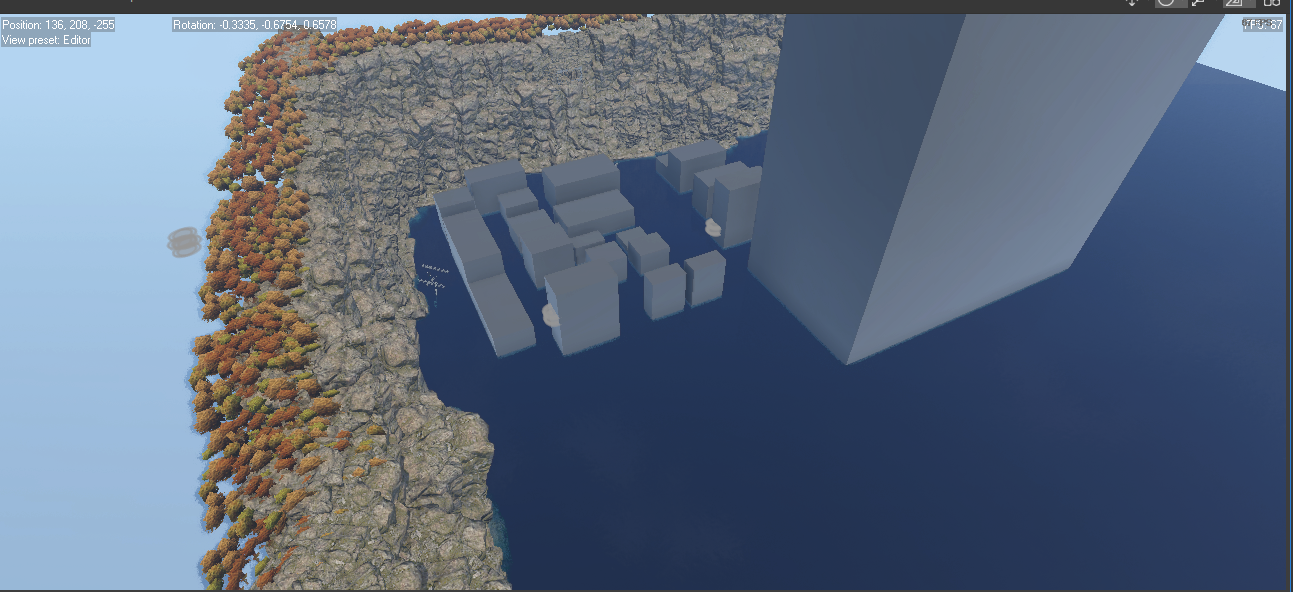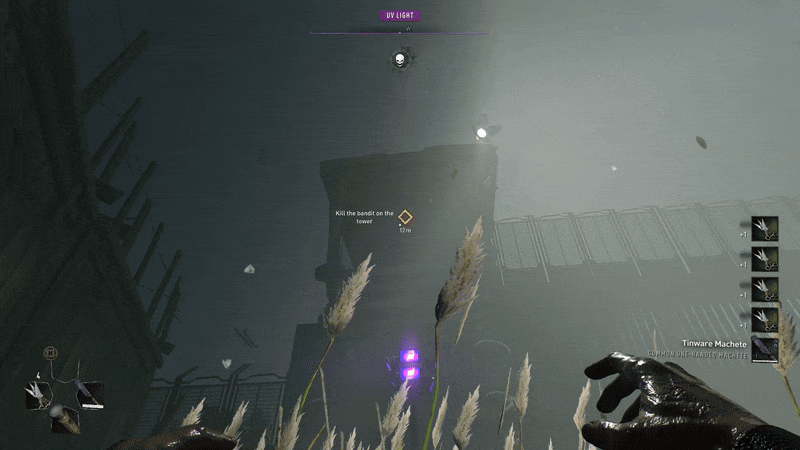
DL2: custom map series
Role
Solo developer
Year
2024
GORE WARNING IN FEW OF THE GIFS AND VIDEOS.
Following up on my initial map, The Sun Mother Story, Aiden follows up on the Sunmother’s request and goes to the hidden city of Vaitala and participates in their ritual of scaling the endless tower. This is where the player spends the next half of their gameplay cycle. I wanted to go for a small yet realistic lively hub world. I wanted to stay true to the dying light lore and locations showing a self-content settlement on the rooftops of a hidden-away quarantined city that is completely flooded. The city has an icon skyscraper which the player will have to go to for the third part of the map. Aiden learns more about the city and the sunmother. He makes friends (others who were invited for the same purpose as Aiden) This is a WIP map and i will be constantly updating my process.
MOD LINK: Sunmother - introduction for Dying Light 2 Stay Human - mod.io
Genre
Custom map for DL2 ( FPS action )
Built on
C Engine (Techland devtools)
Platform
PC
Team
Solo
PROCESS - LAYOUT
For the first task, The whole custom map has multiple level layouts, Quests, Side quests, Combat encounters, Choices, and consequences. This portfolio is to break down a few of those levels, side quests, and combat zones.
This is a preliminary layout for positioning my buildings. Given the setting of rooftop survivors in a completely flooded city, I aim to create a genuine traversal experience
Dying Light 2 features a complex level design system where altitude significantly impacts the parkour experience. However, it’s crucial that the design remains realistic to capture the essence of a flooded city. Because of this challenge, I want to carefully plan the layout before focusing on the height elements
After sketching and creating a rough greybox, I explored the design in the engine and discovered that some buildings lack directional options, which impairs the parkour experience in Dying Light 2. Specifically, when players land on certain buildings—such as those in the top right or bottom right areas—the available movement choices are restricted to only moving forward or left.
Another issue I encountered is that the level feels too expansive for the narrative setting. The large skyscraper (the big box with a huge gap in the middle) tends to obscure the buildings behind it, impacting the overall visual.
Third, The layout didn’t give the city a feel. Too many diagonal buildings. The in-game movement experience felt too linear. This made me redo the layout a little bit
The new layout seems to work way better. the skyscraper fit perfectly into the area without blocking anything.
The in-game movement seems more ideal and the overall parkour felt great. There was no linear path and players can chose multiple paths to reach their point. This felt more like dying light experience.
PROCESS - CLIFFS AND HEIGHT
The second Task was to collect some references and figure out the height variation between the buildings
I went ahead and collected a couple of references to use and on how i want the look and feel of the area. These references include JustCause 3 ( Avalanche studios) and couple of real world flooded settlements or cities
With this in mind, I started to use the grey box to complete the height variations. Along the way i made slight changes to building space too and again played through it multiple times to see how the traversal feels.
The final step is transforming the grey box into fully realized buildings. I’ll achieve this by creating prefabs using the Dying Light 2 development tools, including presets for walls, floors, and other components. The goal is to ensure that these buildings closely resemble those in the base game with an additional twist for storytelling.
This is the most challenging task, as I need to carefully consider the rooftop ambiance. Everything—from the buildings and decals to props and environmental storytelling—must be thoughtfully integrated. A significant portion of my time has been spent on this, trying to balance detail with the limitations of the development tools, which can impact rendering distance and performance.
Given the need to maintain performance, I’ll use ocular planes and single-sided buildings unless a structure needs to be enterable or traversable. This approach helps optimize rendering while still providing a convincing environment.
Ideal zipline locations and gameplay features like paragliders need to be carefully planned, with the environment designed to support these mechanics. The layout must accommodate and enhance these features to ensure a seamless and engaging experience.
A significant challenge is integrating the game’s dynamic situational parkour music into the design. I want to preserve the game's immersive feel, and this dynamic music plays a crucial role in adjusting the level based on its feedback. By aligning the level design with the music, I aim to create an exceptionally enjoyable traversal experience for players.









Added more life to the rooftops, It felt close to the lore and the whole dying light settings in general. This includes the placement of everything. Including climbable surfaces, climbable poles, etc.
Multiple ziplines and swinging ropes have been added between key buildings to facilitate traversal and enhance the narrative of the existing settlement. Additionally, vertical lifts that quickly elevate players to the top have been incorporated into the layout. Two of these lifts are positioned atop the tallest and most significant buildings, which players will frequently revisit for quests.
The next step I wanted to tackle was crafting a proper entry for the player—a scenic vista reveal of the hidden city that offers a cinematic experience.
To stay true to the lore of the setting, Aiden enters the area through an abandoned metro from the old world which cuts through the surrounding mountains.
The next step was to build, A broken-down metro tunnel. Since it’s going to be outside of the gameplay zone and Aiden can never reach it again after the initial opening where the player uses their paraglider to reach the main objective area, i don’t have to focus too much on traversal etc.
Level Layouts - Another Example
The concept for this level was to blend the immersive nighttime gameplay of Dying Light 1 with the dynamic storyline of Dying Light 2.
As the introductory level for the series, it aims to remain straightforward while reintroducing familiar mechanics and offering a fresh challenge to players.
Designed for those who have played at least 50% of Dying Light 2, the map starts with a linear progression but features multiple simple paths in the final quest, allowing for varied completion approaches.
UV lights and normal lights apart from being a night mechanics, can also be used to guide the players on the right path
Players begin the quest with basic game mechanics.
Stats are set at 50% progress.
No weapons available at the start.
Ability to level up and acquire gear as they advance.
Narrative Setting:
Set on a rainy, dark night.
UV light is crucial for survival.
Challenge Elements:
No UV lights available in the latter part of the level, allowing zombies to spawn freely.
Bandits and hostages equipped with UV lamps for safety.
Gameplay Introduction:
Players receive audio cues explaining the situation between the bandit and hostage.
Guides players as they transition into the zone using bus switches.
Strategic Weapon Placement:
A weapon is placed near the bus door switch for visibility and accessibility during interactions.
Stealth Mechanics:
Emphasis on stealth mechanics from the base game.
Reinforces the intended difficulty and gameplay experience.
Level Mechanics
Level Choices
Direct Route:
Engage in combat with zombies to secure a safe environment.
Lockpick the GRE container and rescue the hostage.
Secondary Path:
Pay attention to lighting and level design to discover an alternative route.
Climb on top of the GRE container and access it via a hatch, bypassing combat.
Design Philosophy:
Stays true to Dying Light's quest mechanics.
Offers players both a violent and a peaceful way to complete the objective.
Option A - Players take the direct approach and fight through the zombie. The horde presents a significant challenge, but players who have fought the bandits beforehand will find randomized weapons as loot, which can be used to tackle this challenge. This option is particularly designed for experienced Dying Light players.
Option B - Players can opt for a parkour approach, bypassing the zombies entirely and using the top hatch to access the GRE container. This method is designed to reward exploration, especially for newcomers to Dying Light who might panic at the sight of a zombie horde. By offering this alternative to combat, the level provides players with a strategic option that emphasizes exploration and creativity.








Characters
I’ve categorized the NPCs into two groups: interactable and non-interactable.
Non-Interactable NPCs:
These characters serve to enhance the narrative and bring life to the rooftops.
Each will follow a day-and-night cycle, altering their activities as night falls.
For the base narrative, I introduced four characters who are fellow contenders in the tower climb ritual. Each character has their own backstory, choices, and quests, with player decisions influencing the outcomes of their stories. I opted for a darker theme, leading to endings that are often open to interpretation.
Additionally, these NPCs provide optional side quests that delve deeper into their stories. Players can make choices within these quests that ultimately determine their fates.
PABLO
RENE
MARIA
VIKRAM AND HIS DAD
Some issues I ran into
Due to the limitation of the dev tools, I ran into a problem where the NPC names could not be changed from their base set mesh name.
To overcome this issue, I had to override the vanilla binsclocs file with my custom names, to do this i had to unpack the base game’s file from Steam using 7zip and acquire a specific .scr file which can be manually overwritten by opening the file with a notepad.
The node-based system had limitations when it came to transferring variables between dialogue classes and the base story classes. As a result, managing an increasing number of variables became challenging, raising concerns about which variables to save and which to discard.
Quests/Challenges
Apart from dialogues, To really make Vitala’s ambience better, I set up multiple small side quests/challenges to progress our character’s storyline
These challenges, while staying true to the original Dying Light's theme, have been adapted to better fit my story. They are entirely optional but offer enticing rewards, such as unique items and enhanced relationships with characters, for players who choose to complete them.
These include parkour, combat, and puzzles
They also acted as a fun way for players to explore and interact with their surroundings.
PARKOUR CHALLENGE (RENE)
CLIMBING PUZZLE CHALLENGE (VIKRAM)
Quest and Sound Design
C-Engine Utilization:
Fully leveraged the C-Engine to create custom cutscenes, dialogues, quests, and environmental audio cues.
Ensures an immersive experience that keeps players engaged.
Enhancing Player Experience:
Acknowledged the challenge of getting players to read text.
Incorporated cinematic camera angles and dynamic animations.
Developed a unique dialogue system that adapts to players' playthroughs.
Inspiration from Dying Light 2:
Design elements are influenced by the base Dying Light 2 game.





























